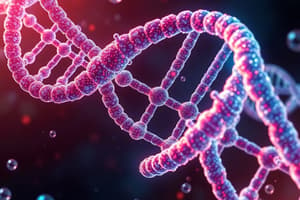Podcast
Questions and Answers
What is the term for the phenomenon where each type of nucleobase on one strand bonds with just one type of nucleobase on the other strand?
What is the term for the phenomenon where each type of nucleobase on one strand bonds with just one type of nucleobase on the other strand?
- Pyrimidine pairing
- Hydrogen bonding
- Purine bonding
- Complementary base pairing (correct)
What is the purpose of the formula C1V1 = C2V2?
What is the purpose of the formula C1V1 = C2V2?
- To determine the pH of a buffer
- To prepare a molar solution
- To calculate the concentration of a diluted reagent (correct)
- To calculate the molecular weight of a substance
What is the value of V1 in the equation C1V1 = C2V2, if we want to prepare 10 mL of 15% concentration of fructose from a stock solution of 50% concentration?
What is the value of V1 in the equation C1V1 = C2V2, if we want to prepare 10 mL of 15% concentration of fructose from a stock solution of 50% concentration?
- 2 mL
- 5 mL
- 7 mL
- 3 mL (correct)
What is the formula used to dilute a molar solution?
What is the formula used to dilute a molar solution?
What is the molecular weight (M.wt) of NaOH?
What is the molecular weight (M.wt) of NaOH?
How many moles of NaOH are present in 400 mL of a 3M solution?
How many moles of NaOH are present in 400 mL of a 3M solution?
What is the purpose of the formula Molarity = Wt / (MW * V)?
What is the purpose of the formula Molarity = Wt / (MW * V)?
What type of bonds hold the two strands of DNA together?
What type of bonds hold the two strands of DNA together?
What is the main function of DNA in living organisms?
What is the main function of DNA in living organisms?
What is the sugar molecule found in RNA?
What is the sugar molecule found in RNA?
What is the term for the combination of a base and sugar in a nucleotide?
What is the term for the combination of a base and sugar in a nucleotide?
What type of bond connects nucleotides in DNA and RNA?
What type of bond connects nucleotides in DNA and RNA?
What is the term for two nucleotides connected to each other?
What is the term for two nucleotides connected to each other?
What is the pyrimidine base found in RNA but not in DNA?
What is the pyrimidine base found in RNA but not in DNA?
What are the two types of nucleotide bases?
What are the two types of nucleotide bases?
What is the term for a long chain of nucleotides?
What is the term for a long chain of nucleotides?
Flashcards
Complementary base pairing
Complementary base pairing
In DNA, the specific pairing of nitrogenous bases (A with T, and C with G) due to hydrogen bond formation.
C1V1 = C2V2
C1V1 = C2V2
A formula used to calculate the concentration of a solution after dilution.
V1 (Dilution)
V1 (Dilution)
The volume of the initial, more concentrated solution required to make a desired dilution.
Molarity Calculation
Molarity Calculation
Signup and view all the flashcards
M1V1 = M2V2
M1V1 = M2V2
Signup and view all the flashcards
Molecular weight of NaOH
Molecular weight of NaOH
Signup and view all the flashcards
Moles of NaOH (3M, 400mL)
Moles of NaOH (3M, 400mL)
Signup and view all the flashcards
DNA Function
DNA Function
Signup and view all the flashcards
RNA Sugar
RNA Sugar
Signup and view all the flashcards
Nucleoside
Nucleoside
Signup and view all the flashcards
Phosphodiester bond
Phosphodiester bond
Signup and view all the flashcards
Dinucleotide
Dinucleotide
Signup and view all the flashcards
Uracil
Uracil
Signup and view all the flashcards
Purine and Pyrimidine
Purine and Pyrimidine
Signup and view all the flashcards
Polynucleotide
Polynucleotide
Signup and view all the flashcards
Study Notes
DNA Structure
- DNA is a molecule that carries genetic instructions used in development, functioning, and reproduction of living organisms and some viruses.
- DNA and RNA are polymeric molecules made up of linear chains of nucleotides.
- Each nucleotide has three parts: a nitrogenous base, a five-carbon-atom sugar, and a phosphate group.
- The combination of base and sugar is called a nucleoside, while the base-sugar-phosphate is called a nucleotide.
- DNA nucleotides are called deoxyribonucleotides (containing 2-deoxyribose sugar), while RNA nucleotides are called ribonucleotides (containing ribose sugar).
- Nucleotide bases can be either a double-ringed purine (adenine (A) and guanine (G)) or a single-ringed pyrimidine (cytosine (C) and thymine (T) in DNA, or uracil (U) in RNA).
- Individual nucleotides are connected through sugar-phosphate bonds, forming a polynucleotide.
- In a DNA double helix, each type of nucleobase on one strand bonds with just one type of nucleobase on the other strand through complementary base pairing.
- Purines form hydrogen bonds with pyrimidines, with adenine bonding only to thymine in two hydrogen bonds, and cytosine bonding only to guanine in three hydrogen bonds.
Buffer Preparation
- Concentration of a diluted reagent can be calculated using the formula C1V1 = C2V2.
- Example: preparing 10 mL of 15% fructose solution from a stock solution with 50% concentration requires 3 mL of stock solution and 7 mL of distilled water.
- Diluting molar solutions can be calculated using the formula M1V1 = M2V2.
- Example: preparing 250 mL of 2M TES buffer from a 5M stock solution requires 100 mL of stock solution.
- Molarity can be calculated using the formula Molarity = (Wt / M.wt) × (1000 / V).
- Example: preparing 3M of NaOH in 400mL requires 48 g of NaOH, with a molecular weight of 40.
Studying That Suits You
Use AI to generate personalized quizzes and flashcards to suit your learning preferences.




